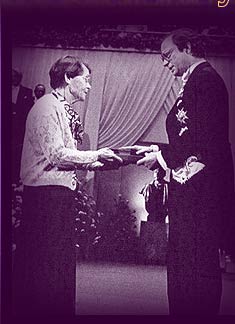












|

Barbara McClintock, more than 40 years after her research on corn pigmentation, receives the Nobel Prize from King Carl Gustav of Sweden.
|
 |

1902-1992 Barbara McClintock
Though American botanist Barbara McClintock conducted the research that led to her discovery of mobile genetic elements in the 1940s, it was not until decades later that scientists began to take her work seriously. McClintock experimented with variation in the colors of corn kernels on a single cob. She tracked pigmentation changes in the corn and observed through microscopic evidence that two transposable genes called "controlling elements" were influencing the corn's pigmentation according to where their ever-changing position was on the corn's chromosomes. Whichever genes became the genetic neighbors of these controlling elements in a given generation of corn accounted for the changes in pigmentation McClintock observed. In 1983, McClintock became the first female recipient of the Nobel Prize for Physiology or Medicine. Scientists today believe "jumping genes," or transposons, may be linked to some genetic disorders such as hemophilia, leukemia, and breast cancer, and may have played critical roles in human evolution.
|
 |